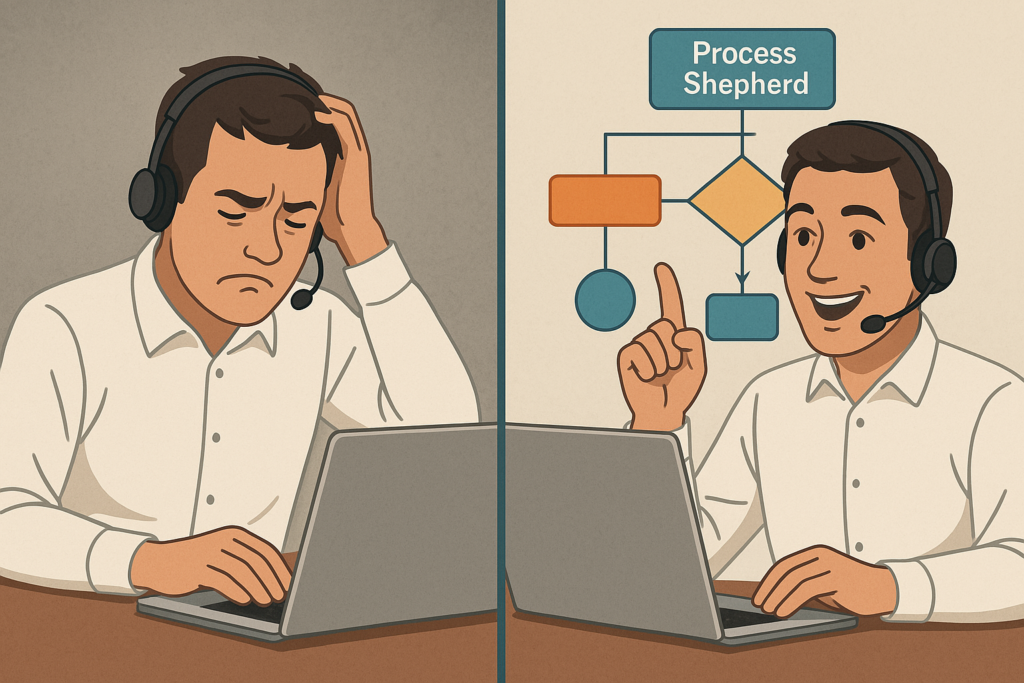
Workflows dictate how your business operates, yet most teams use the wrong type for their needs. Before jumping into automation, understand the 4 foundational workflow categories. Once mastered, you’ll see how Process Shepherd’s guided workflows turn these frameworks into consistent, measurable processes.
The 4 Foundational Workflow Types
1. Sequential Workflow: Step-by-Step Precision
A linear process where tasks follow a strict, unbroken sequence—perfect for standardized helpdesk procedures.
A Tiered ticket resolution (Tier 1 → Tier 2 → Escalation)
New agent onboarding (Access setup → Training → Shadowing)
Pros:
Ensures compliance with SLAs (Service Level Agreements)
Reduces errors in repetitive tasks like password resets tasks
Cons:
Struggles with urgent or atypical tickets
Delays in one step (e.g., missing customer info) stall progress
Example:
A customer support ticket lifecycle:
Ticket creation → 2. Initial diagnosis → 3. Escalation → 4. Resolution → 5. Closure.
2. Parallel Workflow: Best For Multitasking
Multiple tasks happen simultaneously, but somehow collaboratively merging at the end. This speeds up processes significantly when tasks don’t depend on each other. It’s perfect for processes where tasks can be done at the same time to save time.
Use Cases:
Handling inbound calls, emails, and chats concurrently
Simultaneously updating CRM records while resolving tickets
Pros:
Reduces average handling time (AHT)
Balances workload during peak hours
Cons:
Risk of duplicate efforts (e.g., two agents working on the same ticket)
Requires precise coordination
Example:
A call center managing holiday surges:
Team A handles calls → Team B processes email backlog → Team C monitors live chats.
3. State-Machine Workflow: Status-Driven Agility
This type is driven by events. A process moves through different “states” based on specific triggers or actions. Imagine a ticket resolution process – a ticket can be in “Open,” “Pending,” “Resolved,” or “Closed” states, transitioning between them based on agent actions and customer responses. It’s ideal for processes that are event-driven.
Use Cases:
Escalating unresolved tickets after SLA breaches
Routing tickets based on priority (Low → High → Critical)
Pros:
Automatically prioritizes urgent issues
Adapts to real-time customer needs
Cons:
Requires clear escalation rules
Can stall if status transitions aren’t defined
Example:
A VIP customer ticket flow:
New → Assigned → Follow-Up → Resolved → Customer Feedback.
4. Rule-Based Workflow: Automated Decision-Making
With this workflow, decisions are typically made automatically based on pre-defined rules. “If this, then that” logic dictates the flow of the process. You may apply this logic in email routing setup within a helpdesk – emails containing certain keywords are automatically assigned to specific departments based on rules you set up. It’s very effective for automating repetitive decisions and actions.
Use Cases:
Auto-assigning tickets based on keywords (e.g., “billing” → Finance Team)
Triggering SLA violation alerts for overdue tickets
Pros:
Reduces manual triage by 60%
Ensures 24/7 consistency
Cons:
May mishandle complex, multi-issue tickets
Requires regular rule audits
Example:
A helpdesk auto-response rule:
IF ticket contains “password reset” → THEN send predefined reset instructions.
Implementing Workflows with Guided Workflows
Guided workflows provide a structured approach to executing business processes, ensuring consistency and adaptability. Here’s how they address the challenges of each workflow type — without relying on unverified features:
1. Sequential Workflows
Process Shepherd guides users through a fixed sequence of questions or actions, ensuring compliance.
Example - IT Helpdesk:
Agent asks: “Is the server responding to ping?”
Yes → Next question: “Are critical services running?”
No → Branch to: “Initiate reboot protocol.”
Final step: “Document resolution and notify stakeholders.”
2. Parallel Workflows
Process Shepherd splits paths into branches, but true parallelism isn’t its strength. Instead, it prioritizes tasks logically. Example - Customer Support: Agent asks: “Is the issue billing or technical?” Billing → Route to finance team + auto-send payment FAQ. Technical → Guide agent through diagnostic questions.
Why It Works: Focus on Priorities: Guides teams to resolve one thread before another.
⚠️ Critical Tip: Parallel workflows demand careful planning. Before implementation, ask:
Can this process be simplified into smaller, sequential steps?
Are all teams aligned on deadlines and deliverables?
3. State-Machine Workflows
Process Shepherd guides states through conditional logic.
Example - Escalation Management:
State: New → Agent asks: “Can this be resolved in <10 mins?”
Yes → State → “In Progress.”
No → State → “Escalate to Tier 2.”
State: Escalated → Auto-notify manager + set SLA countdown.
Why It Works:
Status-Driven Paths: Decisions trigger state changes, not manual updates.
Auto-Notifications: Escalations alert stakeholders without extra steps.
4. Rule-Based Workflows
During implementation, rules are embedded directly into decision branches.
Example - Spam Filtering:
Rule: “Does the ticket contain ‘FREE’ or ‘URGENT’?”
Yes → Auto-close + tag as “Spam.”
No → Route to agent queue.
Why It Works:
Less Manual Effort: Rules handle and guide repetitive decisions.
Exception Handling: Agents can override rules for edge cases.
How Guided Workflows (By Process Shepherd) Elevate Execution:
While specifics vary across platforms, guided workflows generally enable teams to:
Standardize Processes: Ensure every task follows a consistent path.
Adapt to Exceptions: Handle edge cases without redesigning the entire workflow.
Monitor Progress: Track task statuses and bottlenecks in real time.
Why Guided Workflows Outperform Traditional Tools
Process Shepherd transforms workflows into living systems that:
Adapt to data changes or user inputs.
Measure efficiency with heatmaps and time analytics.
Enforce compliance through mandatory steps.
FAQs
Can decision trees replace workflow builders?
For complex processes like supply chains, no. For helpdesk/call centers, yes—they simplify human-driven decisions.
How to handle multi-department workflows?
Use branching to route tasks (e.g., “Billing?” → Finance | “Technical?” → Engineering).
Are decision trees rigid?
No—Process Shepherd allows override options for agents/managers.
Can I integrate with CRMs like Zendesk?
Yes, to auto-update records based on decisions (e.g., “Ticket resolved” → CRM status closed).
Process Shepherd excels in environments where guided decisions matter more than complex automation, like customer support, IT helpdesks, or field service. By turning workflows into intuitive decision trees, it ensures consistency, reduces training time, and keeps teams focused on outcomes — not process mechanics.
👉 Ready to Simplify Decisions? Try Process Shepherd’s Decision Tree Builder Free.



